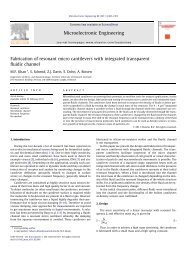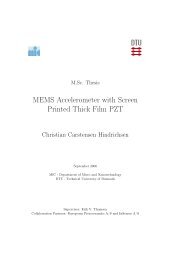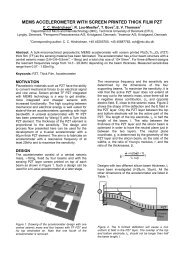Development of a Oxygen Sensor for Marine ... - DTU Nanotech
Development of a Oxygen Sensor for Marine ... - DTU Nanotech
Development of a Oxygen Sensor for Marine ... - DTU Nanotech
Create successful ePaper yourself
Turn your PDF publications into a flip-book with our unique Google optimized e-Paper software.
Chapter 1<br />
Introduction<br />
Roughly 70 % <strong>of</strong> the world is covered by water[1], and have been an inspiration<br />
<strong>for</strong> mankind over the ages, from explorers such as Columbus to works <strong>of</strong><br />
fiction, such as Hemingway’s ’The Old Man and the Sea’. Several time the<br />
oceans have shown the tremendous <strong>for</strong>ces that rest within in various <strong>for</strong>ms<br />
<strong>of</strong> natural disasters such as tidal waves, floods, tsunamis and many other.<br />
However the oceans is also a source <strong>of</strong> life, in fact the original source <strong>of</strong> life,<br />
not just <strong>for</strong> us but <strong>for</strong> the fish that lives below.<br />
This thesis have been subpart <strong>of</strong> a larger project (Fish and Chips), where<br />
the main goal is the development <strong>of</strong> a multi-sensor <strong>for</strong> marine environmental<br />
studies. In that, the prototype <strong>for</strong> a Micro Electronic Mechanical System<br />
(MEMS) have been developed, with then intended use <strong>for</strong> fish tagging. While<br />
this thesis does not have quite as wide a scope, it does focus on one <strong>of</strong> the<br />
more important aspects <strong>of</strong> it, namely oxygen, or rather dissolved oxygen.<br />
There are commercially available dissolved oxygen sensors already today,<br />
however these are more <strong>of</strong>ten than not macro scale sensors attached to a<br />
buoy, and there<strong>for</strong>e only measuring in one place. They can also be attached<br />
to ships, however they will only measure the oxygen level at the surface, and<br />
there<strong>for</strong>e not give a full accurate picture <strong>of</strong> the oxygen level.<br />
Why dissolved oxygen? Well there are many reasons, mainly like us the<br />
fish needs to breathe, and the gills <strong>of</strong> a fish are not all that different <strong>for</strong>m<br />
our lungs[2]. Basically there needs to be enough dissolved oxygen in the<br />
water to favor diffusion <strong>of</strong> oxygen from the water, through the gills <strong>of</strong> the<br />
fish and into the blood. When the oxygen falls below a certain level this<br />
passive diffusion fails to be able to drive, the oxygen into the blood and the<br />
fish suffocates much like a human might at high altitudes. So by monitoring<br />
1










